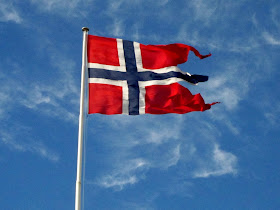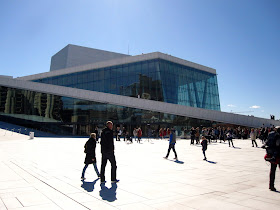One of the main reasons for me travelling to Norway is my interest in Charles XII of Sweden. Yes, Sweden. Norway, at the time, was not an independent nation and was constantly occupied by either Denmark or Sweden. In 1718, Charles led an army to Fredrikshald (now called Halden) which is 90 minutes southeast of Oslo. He was attempting to wrest the strategic fortress of Fredriksten from Danish-Norwegian control in a last ditch effort to turn the tide of the Great Northern War. Unfortunately, the king met his end in the trenches, a victim of a well placed bullet.
I wanted to see the site first hand as I use the time that is left to me here in Europe to uncover Sweden's "Warrior King".
HALDEN
Fredriksten Fortress. Quite a dominating position. It was built in the mid 17th century and continuously reworked until the late 20th century. Note the angular bastions which were designed to deflect cannon fire.
The outer defenses.
Prince Fredrik's Battery (1670-1760).
A view up from the battery. The white building is the bell tower which was used as a lookout post and as a means to raise the alarm when the enemy was sighted. The current tower is the third one on the site and dates from 1833.
A look down into the courtyard which shows the bakery, wellhouse and gatehouse. The fortress was self-sustained due to its position on top of several springs.
Charles' fleet was scattered by a Norwegian raid which forced him to pull back from his first siege attempt.
The lower magazine built in 1683.
The gate house.
A view from the closest ramparts out to the Charles XII memorial. It marks the approximate location of where he fell.
The memorial marker of Charles XII.
"Swedes and Norwegians in travelled memory". This marker is actually the 7th version. The previous six ranged from a basic wooden cross to an elaborate tower with marble reliefs. And all of them were in different locations!
A view from the marker back to the fortress ramparts. The stone pillars out front mark the location of the Swedish trenches. Contemporary sources indicate that the Swedes were under constant sniper fire as the trenches crept closer to the defenses. To bolster morale, the king always appeared amongst his troops and the night of November 30th (Dec 11 in today's calendar) was no different.
The 6th Memorial which is now located within the fortress itself. It was only used from 1935-1938 and was then replaced by the current one.
The first memorial (1723-1731) featured this marble tablet which is now embedded in the gate house entrance.
OSLO
The Royal Palace. It was built in the early 19th century by Charles III John of Norway who was also King of Sweden. The two countries were united under the Swedish crown until 1905. The king's real name was Jean Bernadotte and he was the Marshal of the French army under Napoleon I. When the Swedish royal family died out, his distant claim made him heir apparent. His statue is in the foreground.
The National Theatre.
Oslo Cathedral (1694). Quite a departure from the euro-gothic style.
Houses are constantly being renovated and repainted which makes Oslo a very colorful capital.
The Opera House. Visitors can climb the angled roof all the way to the top for spectacular views of Oslo. See the two pictures below...
A view from the ramparts of Akershus Fortress. More on that site in Part 2.
The Nobel Hall.
Plaza in front of City Hall.































No comments:
Post a Comment